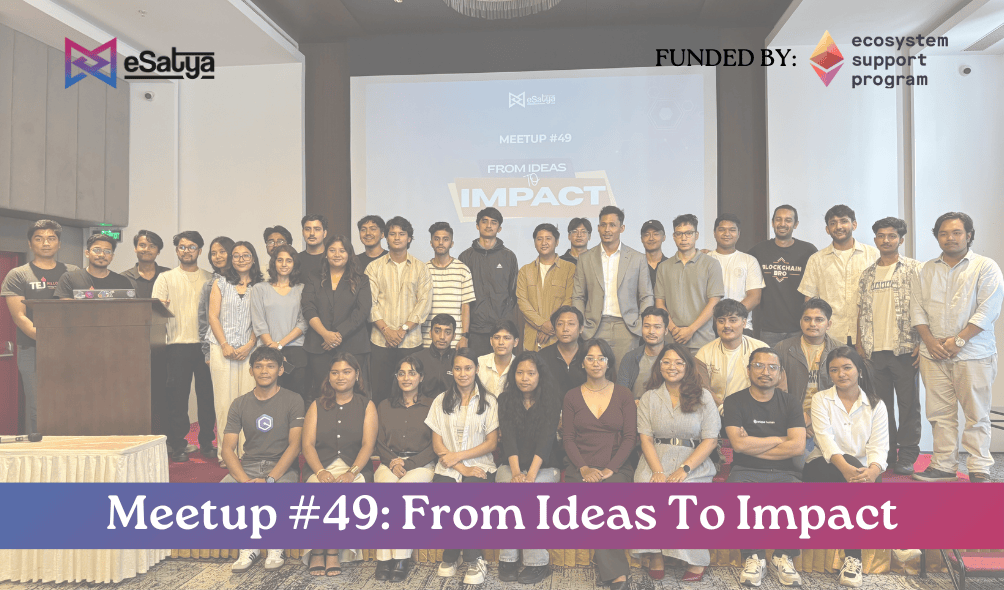On June 26, 2025, at the Annapurna Hall in Vivanta Kathmandu, we hosted Meetup #48: a focused gathering on Blockchain in Humanitarian Innovation, supported by the Blockchain for Good Alliance (BGA) and funded by the Ethereum Support Program (ESP).
As blockchain technology matures beyond the noise of cryptocurrencies and financial speculation, this event placed the spotlight on what truly matters: people.
The meetup explored how blockchain is being actively used to improve lives, from delivering aid faster during crises to building systems that promote trust, transparency, and efficiency in humanitarian response.
Whether you were a developer, aid worker, student, or policy maker, this session was designed to demonstrate that blockchain isn't just future-tech—it's already transforming lives today.
Kicking Things Off
The event began with a warm welcome from Krisha Sherpa, Marketing & Community Coordinator at Rumsan. She introduced the agenda and set the tone for a day filled with meaningful discussions and innovation spotlights.
A total of 56 participants joined from diverse backgrounds, including humanitarian professionals, students, government officials, bankers, and tech enthusiasts.
Message from BGA: Freya Chen
To open the event, a recorded video message from Freya Chen, Executive Director at Blockchain for Good Alliance (BGA), was shared.
She highlighted BGA’s mission: using blockchain not just for finance, but for real impact in development and humanitarian contexts.
Freya outlined BGA’s four key pillars:
🔹Hackathons🔹Incubation Programs
🔹Joint Funding Initiatives
🔹Web3 Oscars
She spotlighted successful projects like EthicHub and proudly announced that Rahat (developed by Rumsan) has been shortlisted for the BGA Spring 2025 Incubation Program : Ignite Project.
Her message encouraged innovators to join this growing ecosystem of builders-for-good.
Keynote by Rumee Singh – CEO, Rumsan
In her keynote, Rumee Singh captured the audience’s attention by addressing the urgent funding cuts and systemic inefficiencies in humanitarian aid.
She emphasized that blockchain is not a theoretical concept and Rahat has already proven its value through partnerships with UNICEF, Mercy Corps, and Danish Red Cross.
She identified two powerful opportunities:
✅ Increasing transparency in aid delivery
✅ Exploring alternative funding models through joint initiatives like BGA
Her call to action: Let’s collaborate, innovate, and bring scalable, effective solutions to the front lines.
Innovation Showcase
Anticipatory Action (AA) – Shristi Khayargoli
Shristi Khayargoli, Senior Business Coordinator at Rahat, explained how blockchain can help act before a disaster strikes.
With Rahat’s Blockchain-Powered Response System, teams can:
⏱️ Access real-time reports
🔐 Use multi-signature verification for trust
💸 Automate fund disbursement triggered by early warning systems
The result: Faster response, transparent fund use, and stronger coordination when it matters most.
Cash & Voucher Assistance (CVA) – Aayushi Karmacharya
Aayushi Karmacharya, Director of Growth & Partnerships, walked us through Rahat’s solution to a common challenge: Where does the aid money go?
She presented:
🔁 Cash Tracker Flow with Handshake Mechanism
📱 Digital Vouchers to replace paper-based systems
These tools ensure:
✔️ Full visibility from donor to recipient
✔️ Tamper-proof and traceable transactions
✔️ Greater trust and accountability in aid distribution
Stablecoins for Crisis Response – Nishu Bade Shrestha
Nishu Bade Shrestha, Business Director at Rumsan, discussed how stablecoins can revolutionize emergency aid. She shared examples from Ukraine, Türkiye–Syria Earthquake, and pilot efforts by Mercy Corps, proving stablecoins can:
🚀 Cut approval delays
🔁 Enable programmable fund releases
💰 Cross borders instantly and securely
Her message: In times of crisis, time is everything, and blockchain can save it.
Blockchain 101: Making the Complex Simple
Ruchin Singh, Managing Director at Rahat and COO at eSatya, led a simplified session on what blockchain is.
From comparing it to a Google Sheet shared with thousands to explaining smart contracts using a vending machine analogy, Ruchin made it accessible for everyone, from coders to aid workers.
He explained:
🔍 The public vs. private blockchain debate
⚠️ Current barriers: regulation, perception, and adoption
🌍 Real-world impact stories that show blockchain is already making a difference
Ask Me Anything (AMA) – Santosh Shrestha
The final session was a high-energy, no-holds-barred AMA with Santosh Shrestha, CTO of Rumsan. Using Slido, participants asked burning questions live.
A few highlights:
-
Blockchain vs Policy Changes: Immutable records? No problem. Just add updated blocks via smart contracts.
-
Trust in microfinance: Blockchain can upgrade traditional systems like Nepal’s Dhukuti by ensuring transparency.
-
User-friendliness: As easy as using a microwave. Beneficiaries don’t need to understand blockchain—they just need results.
-
Offline readiness: Rahat is designed for low-connectivity areas using SMS, NFC, and offline syncing.
And a powerful insight from Michael Siddhi of Standard Chartered Bank:
“Nepal must move toward CBDCs or risk being left behind.”
Key Takeaway
Santosh closed the session with a reflection that resonated deeply with the audience: “To build real solutions through technology, we need mind, money, and time and with the right mindset, resources, and commitment, blockchain can and is making lives better".
Let’s Stay Connected!
This was Meetup #48 of eSatya, and we’re just getting started!
We're grateful to all our attendees, partners, and speakers who made this event a success.
🔗 Stay in the loop for our upcoming sessions and meetups.
📬 Want to collaborate or host a session at your institution?
👉 Connect with us: we're always open to teaming up!


